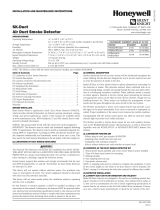Page is loading ...

EB and EBF
Plug-in Detector Bases
INSTALLATION AND MAINTENANCE INSTRUCTIONS
BEFORE INSTALLING
Please thoroughly read the system wiring and installation manuals and the
System Smoke Detector Application Guide, which provides detailed informa-
tion on detector spacing, placement, zoning, and special applications.
NOTICE: This manual should be left with the owner/user of this equipment.
MOUNTING
Detector base, Model EBF (Figure 1A), mounts directly to 3
1
/2- inch and 4-inch
octagon boxes, 4 inch square boxes (with or without plaster rings) and single
gang boxes. To mount, remove the decorative ring by turning it in either direc-
tion to unhook the snaps, then separate the ring from the base. Install the base
on the box using the screws supplied with the junction box and the appropri-
ate mounting slots in the base. Place the decorative ring on the base and rotate
it in either direction until it snaps into place.
Detector base, Model EB (Figure 1B), mounts to 3
1
/2-inch octagon boxes,
4-inch square boxes with plaster rings, and European boxes with 50, 60, and
70 mm screw spacing. Install the base on the box using the screws supplied
with the junction box and the appropriate mounting slots in the base.
FIGURE 1A: EBF 6 INCH MOUNTING BASE
C0941-00
FIGURE 1B: EB 4 INCH MOUNTING BASE
C0942-00
SPECIFICATIONS
Diameter: 6.1 inches (155 mm); EBF
4.0 inches (102 mm); EB
Wire Gauge: 12 to 18 AWG (0.9 to 3.25 mm
2
)
WIRING
All wiring must be installed in compliance with all applicable local codes and
any special requirements of the authority having jurisdiction, using the proper
wire size.
The conductors used to connect smoke detectors to control panels and acces-
sory devices should be color-coded to reduce the likelihood of wiring errors.
Improper connections can prevent a system from responding properly in the
event of a fire. For signal wiring (the wiring between interconnected detec-
tors), it is recommended that the wire be no smaller than AWG 18. However,
the screws and clamping plate in the base can accommodate wire sizes up
to AWG 12. If shielded cable is used, the shield connection to and from the
detector must be continuous by using wire nuts, crimping, or soldering, as
appropriate, for a reliable connection.
See Figure 2 for proper base wiring. Make electrical connections by stripping
about
3
/8 of an inch (10 mm) of insulation from the end of the wire (use strip
gauge molded in base), sliding the bare end of the wire under the clamping
plate, and tightening the clamping plate screw. Do not loop the wire under the
clamping plate. The wiring of the detector base should be checked before the
detector heads are installed in them. The wiring should be checked for conti-
nuity and polarity in the base, and dielectric tests should be performed. The
base includes a space for recording the zone, address, and type of detector
being installed. This information is important to set the address of the detector
head that will later be plugged into the base and to verify the type required
for that location.
FIGURE 2: WIRING THE BASES:
(+)
(–)
(–)
(+)
LISTED COM
PATIBLE
CONTROL
PANEL
OPTIONAL RETURN LOOP
OPTIONAL REMOTE ANNUNCIATOR
(+)
(–)
1
2
3
4
1
2
3
4
C0113-00
TERMINAL DEFINITIONS
T1 (+) SLC in/out T3 (–) SLC in/out
T4 LED
I56-3795-002R
3825 Ohio Avenue, St. Charles, Illinois 60174
1.800.SENSOR2; Fax: 630.377.6495
www.systemsensor.com
1 I56-3795-002R
03-11

Please refer to insert for the Limitations of Fire Alarm Systems
TAMPERPROOF FEATURE
This detector base also includes an optional tamperproof feature that, when
activated, prevents removal of the detector without the use of a tool. To ac-
tivate this feature, simply break off the tab on the lever on the detector base
shown in Figure 3A, and install the detector. To remove the detector from the
base once the tamperproof feature has been activated, place a small-bladed
screwdriver into the small hole on the side of the base and push the plastic
lever (see Figure 3B). This will allow the detector to be rotated counterclock-
wise for removal. The tamperproof feature may be defeated by breaking and
removing the plastic lever from the base; however, this prevents the feature
from being used again.
FIGURE 3A:
INSERT SCREWDRIVER HERE
TO REMOVE DETECTOR
C0114-00
FIGURE 3B:
BREAK OFF
TIP OF LEVER
TO
ACTIVATE TAMPER-PROOF
FEATURE
C0115-00
REMOTE ANNUNCIATOR (RA100Z)
The remote annunciator is connected between terminals 3 and 4 using the
spade lug terminal packed with the remote annunciator. The spade lug termi-
nal is connected to the base terminal as shown in Figure 4. It is not acceptable
to have three stripped wires under the same wiring terminal unless they are
separated by a washer or equivalent means. The spade lug supplied with the
model RA100Z is considered acceptable. See Figure 2 for proper installation.
FIGURE 4:
STRIPPED WIRE
WIRE WITH SPADE LUG
C0116-00
2 I56-3795-002R
©2016 System Sensor. 03-11
/



